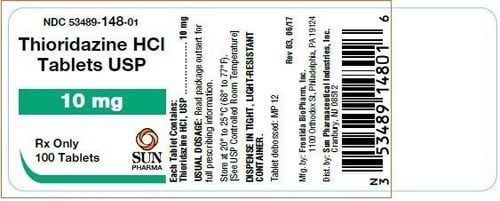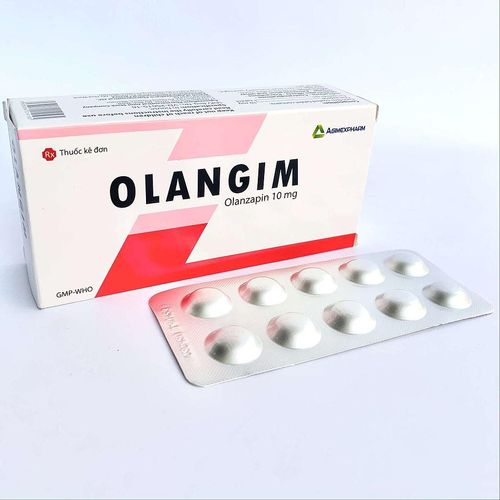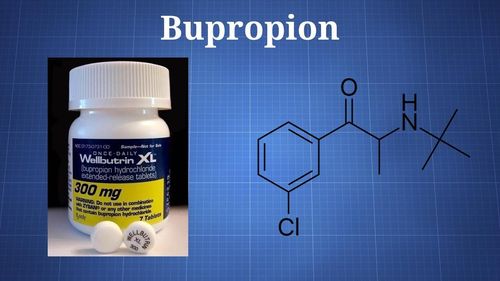This is an automatically translated article.
Ozapine 10 contains the active ingredient Olanzapine, which is a sedative used in the treatment of schizophrenia and some other psychotic conditions. So what are the uses, doses and precautions when using Ozanpine 10?1. What are the uses of Ozapine 10?
Ozapine 10 contains the active ingredient Olanzapine, a sedative and a derivative of dibenzodiazepine. The drug is effective on both positive, negative and inhibitory manifestations of schizophrenia. The mechanism of action involves antagonism at serotonin type 2, type 3, type 6 and dopamine receptors in the central nervous system. Olanzapine also stabilizes mood by partially blocking dopamine D2 receptors.
In addition, the drug also has an antagonistic effect on muscarine receptors to help reduce the risk of extrapyramidal syndrome and antagonize histamine H1 receptors and alpha-1 adrenergic receptors causing somnolence, orthostatic hypotension. . Olanzapine is less likely to increase prolactin secretion, and less likely to cause tardive dyskinesia with long-term treatment.
Ozapine 10 is indicated in the treatment of schizophrenia and other psychotic disorders with pronounced positive or negative symptoms. Ozapine 10 is contraindicated in patients with hypersensitivity to Olanzapine and narrow-angle glaucoma.
2. Dosage and usage of Ozapine 10
Adults:
Treatment of schizophrenia: Initial dose is 5 -10 mg/day, then increased by approximately 5 mg/day over 5-7 days to a target dose of 10 mg/day. The physician may adjust the patient's dose by 5 mg/day at intervals of no less than 7 days up to a maximum dose of 20 mg/day. The usual maintenance dose is 10 - 20 mg once daily.
Manic episodes: Monotherapy: The recommended starting dose is 10 -15 mg orally once a day. The doctor may adjust the dose at 5mg/day, spaced no less than 24 hours apart. The usual maintenance dose is 5 - 20 mg/day and the maximum recommended dose is 20 mg/day.
Combination therapy: The recommended starting dose is 10-15mg/day, taken once. Dosage can be in the range of 5 - 20mg/day.
Prevention of recurrence of bipolar disorder: The usual dose range is 5 - 20 mg/day. If you have already been treated for a manic episode with Olanzapine, your doctor may recommend that you continue the same dose to prevent a relapse of your bipolar disorder. If manic, mixed, or depressive episodes develop, the physician may continue treatment with Olanzapine, but the dose will be adjusted accordingly and accompanied by supportive measures for emotional symptoms.
Children:
Children under 13 years of age: The safety and effectiveness of Ozapine 10 have not been established in this population. Children from 13 -17 years old: When using Olanzapine, it is necessary to be cautious and closely supervised by a specialist. Schizophrenia: The recommended starting dose is 2.5 - 5 mg/day orally once a day. The target dose is 10 mg/day. The doctor may increase or decrease the dose by 2.5 mg or 5 mg, up to a maximum of 20 mg/day. Bipolar disease: The recommended starting dose is 2.5 - 5 mg/day orally once a day. The target dose is 10mg/day. The doctor may increase or decrease the dose by 2.5 mg or 5 mg, up to a maximum of 20 mg/day. Other subjects:
Patients with renal impairment: No dosage adjustment of Ozapine is required in patients with renal impairment. Hepatic Impairment: No dosage adjustment is required except when used in combination with Fluoxetine (as separate components), the initial dose of Olanzapine should be limited to 2.5 to 5 mg daily. Ozapine should be used with caution in cases of hepatitis and liver damage. How to use:
Patients should take the drug once a day as directed by the doctor, with or without food. Tablets should be swallowed whole with water and taken at the same time of day.
3. Side effects of Ozapine 10
Patients using Ozapine 10 may experience undesirable effects including:
Common: Somnolence, extrapyramidal syndrome, dizziness, speech disturbances, insomnia, nightmares, fever, decreased memory, mania, nausea, vomiting, dyspepsia, constipation, weight gain, dry mouth, increased appetite, increased liver enzymes, muscle weakness, tremors, falls, hypotension, tachycardia, peripheral edema micro, chest pain, burning sensation on the skin, hypercholesterolemia, hyperprolactinemia, hyperglycemia, decreased vision and conjunctivitis. Uncommon: Neutropenia, bradycardia, prolongation of the QT interval on electrocardiogram, increased photosensitivity and seizures. Rare: Pancreatitis, neuroleptic malignant syndrome with symptoms such as hyperthermia, muscle spasticity, altered mental status with autonomic nervous system disturbances, unstable heart rate and blood pressure). If you experience these symptoms, the patient should stop using Ozapine and notify the doctor for appropriate treatment.
4. What are the precautions when using Ozapine 10?
Ozapine may cause a dose-related increase in prolactin levels. Clinical manifestations of elevated prolactin levels include menstrual, sexual, and breast changes. Suicidal Intentions: Ozapine should be used with caution in high-risk patients during initiation of treatment. Prescription should be prescribed in the smallest quantity appropriate to the patient's care. Ozapine should be used with caution in patients with severe cardiac disease, hemodynamic instability, previous myocardial infarction, ischemic heart disease. or hypercholesterolemia. Ozapine should be used with caution in patients with reduced gastrointestinal motility such as paralytic ileus because the anticholinergic effect may aggravate the condition. Ozapine should be used with caution in patients with liver disease or liver failure. Ozapine should be used with caution in patients with Parkinson's disease because antipsychotics may worsen dyskinesia. Ozapine should be used with caution in patients at risk for seizures, including those with a history of seizures, head trauma, brain damage, alcoholism, or concomitant treatment with drugs that may lower the threshold. convulsions. Elderly patients may be at increased risk of seizures. Ozapine should be used with caution in patients with urinary retention (patients with prostatic hyperplasia) because the anticholinergic effect may aggravate the condition. Olanzapine concentrations may be lower in smokers. Smokers may require an increased daily dose. When stopping smoking, the dose should also be reduced because Olanzapine concentrations may be higher than when smoking stops. Pregnancy: There are currently adequate data on the safety of Ozapine in pregnant women, so use during pregnancy only when the benefits outweigh the risks. Lactation: Olanzapine is excreted in human milk and may cause CNS effects in nursing infants. Ozapine 10 should not be used in nursing women.
5. Drug interactions
Concomitant use of Ozapine 10 with some drugs can cause interactions, affect the effectiveness of treatment and/or increase toxicity. It is best for patients to inform their doctor of all medications they are taking for advice. Here are some interactions to watch out for when using Ozapine:
Levomethadyl: Increased cardiotoxicity such as prolongation of the QT interval, torsades de pointes and cardiac arrest. Metoclopramide: Increased risk of extrapyramidal and neuroleptic malignant syndromes. Central Nervous System Depressants: Alcohol and benzodiazepines may potentiate the orthostatic hypotensive effects of olanzapine. CYP450 inhibitors such as caffeine, erythromycin, ciprofloxacin, cimetidine, quinidine and some antidepressants may increase blood levels and increase olanzapine toxicity. Dopamine, adrenaline or other beta-adrenoceptor-like agents should not be used in patients being treated with olanzapine, as excessive hypotension may be expected. CYP450 inducers such as Phenobarbital, Phenytoin, Carbamazepine, Rifampicin, and Omeprazole may decrease blood levels of Olanzapine. Ozapine may potentiate the effects of anticholinergics and potentiate the effects of antihypertensives. Ozapine may reduce the effects and toxicity of drugs to treat Parkinson's disease This article provides general information about Ozapine 10. The above information is for reference only and is not a substitute for guidance. medical staff. Since Ozapine is a prescription drug, patients should consult their doctor or pharmacist before taking it.













